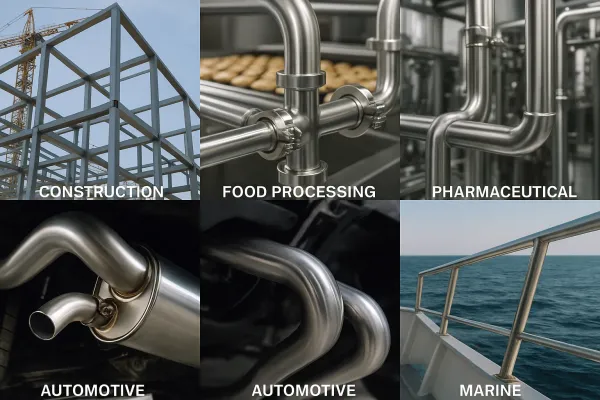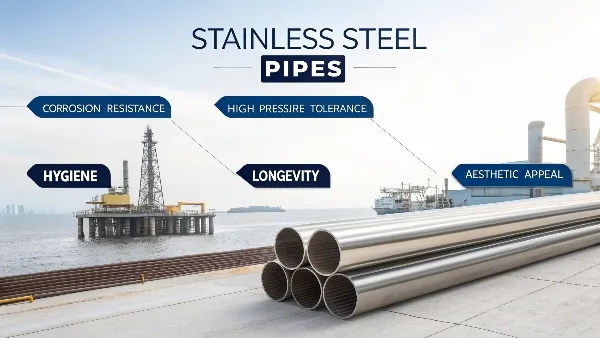Tired of leaks, rust, and surprise shutdowns? Stainless steel tubes fix these headaches fast.
Stainless steel tubes carry liquids and gases, reinforce structures, and shield sensitive goods across construction, food, pharma, automotive, and marine projects.

I bump into stainless steel tubes everywhere—inside breweries, under city streets, even along seaside boardwalks. Once you notice them, you start spotting their shiny outlines holding our world together. Let me walk you through why they matter and how to choose the right one for your next job.
Projects fail when pipes corrode, clog, or crack. Stainless steel pipes dodge those disasters.
They fight corrosion, survive high pressure, stay hygienic, last decades, and look good doing it—saving owners money and stress over the long haul.

Think back to the last time a rusty pipe burst. Cleanup costs piled up, schedules slipped, and someone fielded angry calls at 2 a.m. I’ve seen factories lose entire production days because a bargain‑basement carbon‑steel elbow finally gave way. Stainless steel pipes prevent that misery.
Resistenza alla corrosione is the star. Chromium in the alloy forms a self‑healing skin that blocks oxygen and moisture. I installed 304 pipes on a seafood pier five years ago; salty wind still hasn’t left a mark. Strength and durability come next. These pipes shrug off vibrations and high pressures that would split lesser metals.
Hygiene is huge for food and pharma. A dairy client replaced plastic hoses with polished stainless pipelines and slashed bacteria counts by double digits. Smooth walls wipe clean in seconds, no hidden nooks for microbes.
Maintenance? Minimal. No repainting, no liners, no frequent checks. Over a 20‑year span, a stainless system often costs less than cheaper rivals once you count repairs, coatings, and downtime. On top of that, builders love the sleek finish—balcony railings, hotel lobbies, and airport handrails sparkle without extra polish.
| Advantage | Why it Matters | Where I’ve Used It |
|---|---|---|
| Resistenza alla corrosione | Stops rust and leaks | Coastal factories, desal plants |
| High strength | Handles pressure and impact | Chemical reactors, oil rigs |
| Hygienic surface | Keeps products pure | Breweries, hospitals |
| Low maintenance | Cuts life‑cycle cost | Municipal water grids |
| Attractive look | Doubles as décor | Shopping‑mall railings |
| Shape flexibility | Fits tight spaces | Machine frames, art pieces |
If a system is critical or conditions are tough, someone has probably specced stainless.
Tubi in acciaio inox serve construction, chemical plants, water systems, food lines, car parts, and offshore platforms because other materials fail too soon.

Walk through a skyscraper: elevator shafts hide stainless hydraulic lines; rooftop cooling towers send chilled water down stainless risers; lobby handrails gleam in brushed 304. Out at a refinery, miles of 316L pipe shuttle hot acids day and night—no flaking paint, no emergency welds.
Food processors rely on stainless for every step: milk arrives in 3‑inch sanitary tube, heats in pasteurizers, cools in plate exchangers, then flows to filling heads—all without a flavor‑tainting speck of rust. I once helped a craft brewery swap PVC hoses for stainless; contamination reports dropped, and the beer picked up a cleaner taste.
Water utilities pick stainless for fire mains and potable‑water headers. The pipes outlast ductile iron two‑to‑one, and nobody complains about metallic flavors. In cars, thin‑wall stainless tubing vents fuel vapors and reinforces roll cages while trimming weight.
Now picture an offshore rig hammered by salt spray and shifting loads. Duplex stainless risers carry produced water to separators without pitting or cracking, saving costly shutdowns 150 km from shore.
| Sector | Typical Stainless Job | Key Payoff |
|---|---|---|
| Buildings | Handrails, HVAC lines | Zero rust, polished look |
| Chemicals | Acid transfer, boilers | Long service at high temp |
| Food & Pharma | Milk, beer, WFI loops | Sterile, easy to clean |
| Water | Fire lines, desal headers | Decades of leak‑free flow |
| Automotive | Exhausts, crash bars | Light yet tough |
| Marine | Ballast, platform risers | Beats saltwater attack |
Perfection doesn’t exist—stainless has a few quirks to budget for.
Sticker shock, skilled welding needs, chloride pitting, thermal expansion, and energy‑heavy production can trip up an otherwise solid plan.
Let’s tackle cost first. Nickel, a key ingredient, trades like a roller coaster. I’ve watched bids jump 15 % in a week. When budgets are tight, managers panic. The fix? Compare total life‑cycle cost—not just purchase price. Stainless often wins once you factor repairs and downtime.
Welding is another hurdle. Good stainless welds demand purge gas, correct filler, and low heat input. Skip any step and you risk brittleness or ugly brown sugar lines. In regions short on trained welders, prefab spools or mechanical couplings can bridge the skills gap.
Chlorides spell trouble for basic 304. Swimming pools, de‑icing salts, or bleach cleaning can pit it fast. Upgrading to 316 or duplex alloys solves it but raises the price. Choosing the right grade, not just “stainless,” matters.
Then there’s thermal expansion. Stainless stretches more than carbon steel when heated. Long steam lines need expansion loops or joints, or they’ll buckle supports. Engineers handle this easily—just remember to model it.
Finally, environmental footprint: melting chromium and nickel takes big energy. Opting for high‑recycled‑content steel eases the impact. End‑of‑life scrap value helps too—stainless recycles at high rates.
| Challenge | Impact | Practical Work‑around |
|---|---|---|
| High price | Budget strain | Life‑cycle analysis, bulk buys |
| Skilled welding | Weak joints if mishandled | Certified welders, prefab sections |
| Chloride pitting | Localized leaks | Choose 316L/duplex, add coatings |
| Thermal growth | Stress on supports | Install loops, anchors, sliders |
| Energy input | CO₂ footprint | Use recycled feedstock |
When precision or style counts, tubing steps in.
Steel tubing delivers tighter tolerances, lighter weight, and more shapes than standard pipe—perfect for frames, furniture, and custom machinery.
Pipe sizes follow an old “nominal bore” chart—inside diameters wander, wall thickness varies, and outside diameter is mostly a convenience number. Tubing, by contrast, lists exact OD and wall, often to ±0.05 mm. That accuracy lets robots weld bicycle frames without shims and keeps hydraulic cylinders sliding smoothly.
Shapes are another win. I’ve supplied square tubing for minimalist balcony rails, rectangular tubing for truck bed extensions, even oval tubing for gym equipment grips. Forming mills can tailor a profile that fits both load paths and design flair, something pipe simply can’t match.
Weight matters, too. By moving metal farther from the center, square tubing resists bending better than a round pipe of the same mass. A Canadian snow‑park builder shaved 12 kg off each support arm and still beat safety factors.
Finish is smoother because many tubes are cold‑drawn or polished. Furniture makers love that—weld, buff, done. No scale removal, no heavy grinding.
| Caratteristica | Steel Tubing | Steel Pipe |
|---|---|---|
| Dimension control | Precise OD and wall | Nominal bore, wide tolerance |
| Shape choices | Round, square, rectangle, oval | Mostly round |
| Strength‑to‑weight | High, uses material efficiently | Più basso |
| Aesthetic finish | Smooth, ready to paint or polish | Rough, scaled |
| Common uses | Frames, décor, hydraulics | Fluid transport |
A personal example: a boutique hotel asked for razor‑thin balcony rails overlooking the sea. Standard pipe looked clunky. We switched to 304 square tubing, 30 mm sides, 2 mm wall. The result feels light as air yet meets local wind‑load codes—guests barely notice the barrier between them and the horizon.
Stainless steel tubes fight rust and failure where other metals quit, yet smart design means weighing their higher price against decades of worry‑free service.
| Industria | Application Example | Corrosion Resistance |
La forza | Hygiene |
|---|---|---|---|---|
| Costruzione | Building frameworks, handrails | 9 | 10 | 6 |
| Food Processing | Sanitary tubing, conveyors | 8 | 8 | 10 |
| Pharmaceutical | Cleanroom piping, reactors | 8 | 7 | 10 |
| Automotive | Exhaust, hydraulic lines | 8 | 9 | 6 |
| Marine | Railings, hull piping | 10 | 8 | 7 |